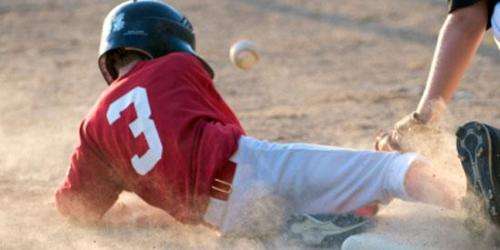Baseball is great for kids, but injuries can be serious

Baseball, America's favorite pastime. From watching a child's first T-ball game to aspirations of playing in the Little League World Series, there is just something special about kids and baseball. Though baseball is one the safest sports for kids, there are still risks that can lead to serious injury.
"All kids should be involved in physical activity and baseball is a great, safe way to get kids exercising, help them develop eye/hand coordination, deepen concentration skills and learn how to work as a team," said Jerold Stirling, MD, Pediatric Sports Medicine specialist at Loyola University Health System in Maywood, Ill., and chair of the Department of Pediatrics at Loyola University Chicago Stritch School of Medicine. "Still, parents and coaches need to be attentive to ensure all players and fans are safe during the game."
Some of the most common, but unrecognized, baseball injuries involve the eyes. Nearly 40,000 eye injuries occur from sports and recreational activities and baseball is one of the leading causes.
"Children are especially vulnerable to eye injury because they don't have the same depth perception," Stirling said. "Be especially careful if your child wears glasses. Make sure they wear protective lenses and consider a face shield for the batting helmet."
He believes the ideal age for children to start playing baseball is age 5 when they can become part of a T-ball team.
"A child's hand/eye coordination and ability to concentrate really start to develop at age 5 and that can play a role in keeping kids safe while playing a game," Stirling said.
Eye injuries are most common when a batter is hit by a wild pitch. Especially in games with younger children when pitching is more erratic, Stirling suggests coaches and parents teach batters to turn their backs toward the ball and their heads away from the ball.
"Pitchers and catchers are the most prone to injuries," Stirling said. "Pitchers tend to have more shoulder and elbow injuries due to overuse. Catchers tend to encounter the most traumas with foul balls being hit off their body and painful collisions at home plate."
To ensure a young pitcher won't be sidelined with an injury, Stirling said to keep an eye on that pitch count and teach proper technique. He also said children and adolescents younger than 14 should not throw curve balls, and sliders should not be thrown until a child is age 16 or older.
"Pay attention to pain. Elbow and shoulder injuries can be very dangerous as they may affect the growth plate. If your child is throwing erratically or says he or she is in persistent pain, get it checked out with a trainer or physician," Stirling said.
Though it may seem obvious, most injuries occur because people aren't paying attention.
"Accidents often occur when a child is not actively in the game but still in the area such as in dugouts and on-deck circles," Stirling said. "Coaches and parents need to make sure everyone is paying attention to where the ball is whether they are off or on the field. The ball comes at you quickly, so pay attention."
Dugouts should be taller than the children's heads to ensure adequate protection. On-deck circles should not be on the playing field and should be in an area where the on-deck batter and those passing by can't be hurt.
To promote safety for fans and players he encourages teams to have a weather radio at every game.
"Lightning is very dangerous and an open baseball field is not safe. A weather radio can help coaches, umpires and parents make informed decisions about calling games to make sure everyone is safe," Stirling said.
Another safety hazard are bats in motion. The most likely cause of injury is when a bat is thrown and this should be prohibited. Also, bats should be labeled with a performance rating of 1.15 or lower and metal spikes are unnecessary for young players.
"Metal spikes are more likely to cause injury than improve a player's performance. They just aren't needed at that level," Stirling said.
Even with the best prevention, injuries will occur. A first-aid kit should be at every baseball field and at least one adult at the field should know the basics in first aid. Also, know where the nearest medical center is in case of serious injury or emergency.
"Having been involved with baseball as a player and parent for numerous years I know what a great game it is and leagues have come a long way with ensuring kids are safe. There is no such thing as a completely risk-free sport so just be prepared and have a plan in place," Stirling said.


















